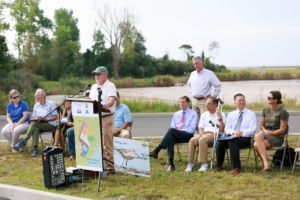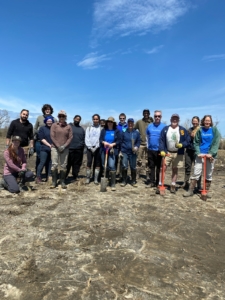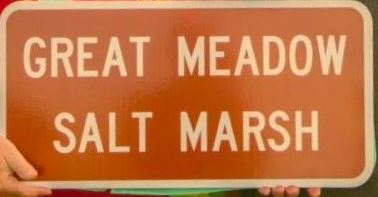State Lawmakers Applaud Restoration of Stratford’s Great Meadows Marsh
State Representative Joe Gresko, (D) 121st Connecticut House District
State Representative Phil Young (D) 120th Connecticut House District
State Senator Kevin Kelly (R) 21st District
Connecticut’s coastline has received an exciting refresh: After years of planning and fundraising, 34 acres of salt marsh and other important coastal habitat has been restored at Great Meadows Marsh, a globally important bird area, approximately 270 species of birds can be seen at different times of the year. Great Meadows Marsh was once described by Roger Tory Peterson as one of the best coastal bird habitats in the United States, and part of Stewart B. McKinney National Wildlife Refuge. The public is now welcome to visit the marsh’s old – and new – trails, and take in the sights of fall migration via two viewing platforms.
 Since construction began in October 2021, Great Meadows Marsh has transformed into a haven for threatened plants and animals, and community access has been greatly improved. Over 155,000 native coastal plants and shrubs were added to the site by the 12 paid, seasonal “Salt Marsh Stewards” from Stratford and Bunnell high schools – with the help of three crew leaders and over 150 volunteers; a new creek restored the natural flow of salt water in and out with the tides; grassy mounds were created to provide an elevated home for nesting Saltmarsh Sparrows; and two viewing platforms were built (soon to become ADA-accessible).
Since construction began in October 2021, Great Meadows Marsh has transformed into a haven for threatened plants and animals, and community access has been greatly improved. Over 155,000 native coastal plants and shrubs were added to the site by the 12 paid, seasonal “Salt Marsh Stewards” from Stratford and Bunnell high schools – with the help of three crew leaders and over 150 volunteers; a new creek restored the natural flow of salt water in and out with the tides; grassy mounds were created to provide an elevated home for nesting Saltmarsh Sparrows; and two viewing platforms were built (soon to become ADA-accessible).
“This is an incredible accomplishment resulting from the work of so many to restore and revitalize the marsh, protect wildlife, rebuild ecosystems, and combat the effects of climate change,” said Senate Republican Leader Kevin Kelly (R-Stratford). “To see this project completed with the restoration of 34 acres of salt marsh is wonderful and transformative. This could not have been done without the 12 students from Stratford and Bunnell high schools who worked as Salt Marsh Stewards, as well as their crew leaders and over 150 volunteers who gave their time. Our entire community shares our deepest gratitude with all who invested in this project to improve CT’s coastline and give our beautiful native plants and wildlife the ability to thrive. I look forward to visiting with my kids and grandkids, and seeing future generations learn about the importance of protecting and preserving our coastline and salt marsh.”
Stratford State Representative Joe Gresko was one of many who invoked the memory of Gresko’s predecessor, Soundkeeper Terry Backer. “Believe me, he’s in my ear all the time saying ‘What are we going to do next?’” Gresko said. Gresko, House Chair of the Environment Committee, said: “It was an honor meeting and working with the Stratford High School stewards to help restore the native plant species. You can see new growth already. Many thanks to all who saw this project through many years. The Stewart B. McKinney National Wildlife Refuge and Great Meadows Marsh protect our coast from the effects of climate change, while hopefully fostering continued thoughts of environmental conservation for all of Connecticut.”
 U.S. Rep. Rosa DeLauro, D-Conn., chair of the powerful Appropriations Committee in Congress, said the project was “a long time in coming, but we are here.” She congratulated the students and said it was encouraging to hear their stories. “Now more than ever, your effort could not be more critical,” DeLauro said.
U.S. Rep. Rosa DeLauro, D-Conn., chair of the powerful Appropriations Committee in Congress, said the project was “a long time in coming, but we are here.” She congratulated the students and said it was encouraging to hear their stories. “Now more than ever, your effort could not be more critical,” DeLauro said.
U.S. Sen. Richard Blumenthal, D-Conn., also thanked the stewards, as well as conservationists, advocates, activists, who he said “really are the heroes in this fight. Less than a year ago, we stood here to announce that this important coastal habitat would be restored and today we celebrate the completion of that worthy and necessary project,” Blumenthal said. “This restoration of 34 acres of salt marsh has not only created a healthy habitat for birds, fish, native plants and all kinds of animals, but also a recreation opportunity for people to fish, bird walk and talk a peaceful walk.”
Attorney General William Tong said that “sometimes lawsuits and investigations can result in resources that help to fund vital projects like this. “This is resiliency,” Tong said. “This is literally a barrier that protects all of us.”
Project collaborates Audubon Connecticut, the National Oceanic and Atmospheric Administration, U.S. Fish and Wildlife Service, and Connecticut Department of Energy and Environmental Protection will dedicate three additional years to monitoring project outcomes and improving upon their successes. Invasive species will continue to be managed, and additional native plants and shrubs will be put in the ground.
The salt marsh at Great Meadows was once more than 1,400 acres, but largely due to development, it had been reduced to less than 700 acres. As well, because of dredged soils brought in as fill, colonization by non-native plants, and sea-level rise, portions of it no longer functioned properly. The degraded marsh produced abundant mosquitoes that plagued locals and visitors for years. Now, the restored marsh and its creeks provide healthy habitat for Horseshoe crabs and Blue crabs, the beautiful and endangered Marsh Pink flower, Saltmarsh Sparrow and other migratory birds, and fish like Atlantic Silverside and Menhaden.
Funding for the project included $3.65 million from the U.S. Fish and Wildlife Service and Environmental Protection Agency, the Nature Conservancy, the Army Corps of Engineers In Lieu of Fee Program, the Robert F. Schumann Foundation, and the Jeniam Foundation. More cleanup funds — nearly $1 million — came from settlements from polluters at nearby contaminated sites: Raymark Industries, Lordship Point Gun Club, and General Electric on the Housatonic River.
Audubon Connecticut’s Corrie Folsom-O’Keefe noted the area’s importance to the saltmarsh sparrow, an elusive species she hadn’t seen before. The birds use thatch from spartina patens, a type of saltmeadow cordgrass planted at the marsh, to build their nests.
Expected Project Outcomes Include:
- Mosquito populations reduced and human health concerns addressed. A more natural ebb and flow of salt water in and out of the marsh with the tides – rather than pools of sitting water – will reduce breeding grounds for mosquitoes.
- Native marsh vegetation and wildlife habitat re-established. ~170,000 native coastal plants and shrubs will be planted across 15 acres.
- Bird and other wildlife habitat created and/or improved. A new strategy will be tested to create Saltmarsh Sparrow nesting habitat. If effective, it could be expanded coast-wide.
- Fish and other aquatic habitat restored and/or improved. Soil fill and invasive plants will be removed to restore habitats for a variety of fish, crabs, and other aquatic animals that call saltmarshes and their creeks home.
- Improved access for the community. A long-closed trail will re-open, and one viewing platform will be removed and replaced with two new ADA-accessible platforms.
- Compensating for the impacts from pollution. Settlement funds from polluters that damaged the environment were leveraged to support these restoration efforts.

